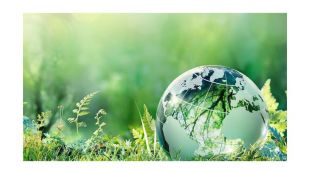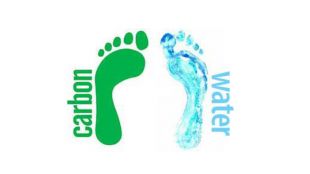Урок за темою "Ecology. Carbon and water footprints."
- Reading text 1.docx docx
- Reading text2.docx docx
- Žᡠπ᫬π.docx docx
- ÅαѺѡΓᵿ∩ Power Point.pptx pptx
Carbon footprint
Most energy in the world is produced by burning fossil fuels like petroleum, coal and gas. They are called "fossil fuels" because they come from fossils of ancient plants and animals, which were in the ground for thousands of years. Those plants and animals had carbon in them. So when we burn petroleum, gas, and coal, the carbon becomes carbon dioxide (CO2) and goes into the air as smoke. This makes pollution. It also makes the greenhouse effect, which means that the carbon dioxide makes the earth warmer, like a greenhouse.
A carbon footprint is the carbon dioxide (CO2) that is put into the air. Your carbon footprint has two parts: the primary and the secondary. The example of primary footprints is the CO2 produced by travelling and using electricity. The secondary footprints include the CO2 put into the atmosphere when factories make things that you buy.
Questions to answer:
- In which way is most energy in the world produced?
- What are fossil fuels? Where do fossil fuels come from?
- What happens when we burn gas, petroleum and coal?
- What is carbon footprint?
- What are the two types of carbon footprint?
Questions to ask:
- What does water footprint show?
- What does our primary water footprint include?
- What is our secondary footprint?
- What is the world’s most freshwater used for?
- What else do you need water for?
Water footprint
Water is important in our daily lives. But sometimes the size of our water footprint is shocking. It shows the amount of water a person uses directly or indirectly, every day.
All day we use water directly. This is our primary footprint. This includes the water we drink, the water we need for a shower or the water we use to wash the dishes.
But what about the water that we use indirectly: the water used to produce, grow or make things that we buy? This is our secondary footprint and sometimes it is much bigger than we think. For example, 70% of the world’s fresh water is used for growing plants and animals, which are used to produce food for us. So the things we eat can make a big difference. You also need water to make almost anything from a computer to a T-shirt.
Questions to answer:
- What does water footprint show?
- What does our primary water footprint include?
- What is our secondary footprint?
- What is the world’s most freshwater used for?
- What else do you need water for?
Questions to ask:
- In which way is most energy in the world produced?
- What are fossil fuels? Where do fossil fuels come from?
- What happens when we burn gas, petroleum and coal?
- What is carbon footprint?
- What are the two types of carbon footprint?
ПЛАН –КОНСПЕКТ УРОКУ З АНГЛІЙСЬКОЇ МОВИ
9 КЛАС
Тема: Екологія
Тема уроку: Carbon and water footprints
Ключові компетентності:
- Розуміння тексту за темою.
- Отримання інформації за допомогою опитування співбесідника.
- Спілкування про екологічні проблеми та обговорення конкретних дій для їх вирішення.
- Узгодження плану дії у групі.
Інтерговані змістовні лінії: Усвідомлення персональної відповідальності за стан навколишнього середовища, відповідальне споживання.
Обладнання уроку:
- Комп’ютер та мультимедійний проектор
- Презентація PowerPoint
- Тексти для читання
- Підручник Gateway B1 2nd edition
- Відео з підручнику Gateway B1 2nd edition, Unit 6 Life Skills
- Папір та письмове приладдя для створення постерів
ХІД УРОКУ:
Lead-in
Use the Power Point presentation (slide 1) to bring up the topic of ecological problems and slide 2 to revise/teach vocabulary connected with ecological problems.
Vocabulary to revise: ozone layer, pollution: water, land, air pollution, drought, flood, global warming, greenhouse effect, recycling
Discuss briefly some of the issues their country has recently been experiencing.
Teacher: As you remember, we are talking about ecological issues. Let’s see what problems we are facing. Look at the screen and say the words for the images you can see.
Objective discussion
Tell students they are going to see an image that shows the topic of today’s lesson (slide3). Ask students what they think they can see. Elicit ‘footprint’. Say: A footprint on the sand which is just a mark that you leave by walking There is nothing wrong with leaving footprints on the sand as a wave will wash them away very soon and they will disappear forever. The way you live also leaves a mark. Many things we do in life contribute to climate change. In today’s lesson you will learn about our environmental footprints. which, unlike footprints on the sand, for a long time. They might even make life on our planet impossible for people in future. By the end of the lesson we will try to come up with ways to make our ecological footprints smaller. In about 30 minutes you will have to make a list of things which will help us reduce our ecological footprints.
Instruction
Say: We walk on two feet. Similarly, we create two kinds of ecological footprints: a carbon footprint and a water footprint (slide 4). You can find out about these two kinds of footprints from the texts on the blue and on the yellow paper which you can see on your desks. But you don’t have enough time to read both of them. That’s why, each of you is going to read about only one of them and become an expert in that kind of footprint. Your partner will read the text about the other kind of footprint and also become an expert in it. After you’ve learned about your kind of footprint, you have to answer your partner’s questions about the footprint you’ve learned about. Of course, you can’t rely on the information that comes just from one expert. You will have to talk to another expert. After that, we will find out what you have learned by reading and talking to experts.
Students work in pairs. Student A reads text 1 and student B reads text 2. Walk across the class and help students with vocabulary if necessary. Then they ask each other questions to find out about the other kind of footprint. When they have finished, go through the questions in the handouts and discuss the answers to all the questions as a class.
To encourage students to think of the practical implication of the recently learned information, ask them to think of two aspects of their life: the way of spending their free time and the way of travelling. Elicit that playing sports outside leaves by far a smaller carbon footprint than playing video games or watching TV. Similarly, walking by foot or cycling contributes global warming less than going by car.
Movement break:
Ask students to stand up and encourage them to join in the dancing movements in the video:
https://www.youtube.com/watch?v=uMuJxd2Gpxo
Practice:
Tell students they are going to watch a video, which shows students talking about what they are doing in their school to reduce their carbon and water footprints. While watching they have to complete the sentences in their Student’s books on page 75, ex 6. Play the video twice. Discuss the answers as a whole class.
Answers:
- Recycling
- 11/eleven
- Cans, bottles
- Paper
- Little
- Forgot
- 12/twelve
Making posters:
Tell students that they can create their posters with ideas for other students about what exactly they can do to reduce their carbon and water footprints. Make sure each group has paper and marker pens of different colours. Students work in grouts. Assign students’ responsibilities: the timer, the writer, the brainstormer(s) and the speaker. As an outcome of this activity, students present their posters to the class, tell the class what actions they have included and briefly explain their choices.
Assessment:
Give feedback on students’ performance in the lesson.
Homework assignment:
Tell students they can calculate their personal ecological footprint online.
http://www.parkcitygreen.org/Calculators/Kids-Calculator.aspx


про публікацію авторської розробки
Додати розробку








